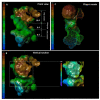Carbon Nanomaterials (CNMs) and Enzymes: From Nanozymes to CNM-Enzyme Conjugates and Biodegradation
- PMID: 35160982
- PMCID: PMC8838330
- DOI: 10.3390/ma15031037
Carbon Nanomaterials (CNMs) and Enzymes: From Nanozymes to CNM-Enzyme Conjugates and Biodegradation
Abstract
Carbon nanomaterials (CNMs) and enzymes differ significantly in terms of their physico-chemical properties-their handling and characterization require very different specialized skills. Therefore, their combination is not trivial. Numerous studies exist at the interface between these two components-especially in the area of sensing-but also involving biofuel cells, biocatalysis, and even biomedical applications including innovative therapeutic approaches and theranostics. Finally, enzymes that are capable of biodegrading CNMs have been identified, and they may play an important role in controlling the environmental fate of these structures after their use. CNMs' widespread use has created more and more opportunities for their entry into the environment, and thus it becomes increasingly important to understand how to biodegrade them. In this concise review, we will cover the progress made in the last five years on this exciting topic, focusing on the applications, and concluding with future perspectives on research combining carbon nanomaterials and enzymes.
Keywords: carbon nano-onions; carbon nanodots; carbon nanomaterials; carbon nanotubes; enzymes; fuel cells; graphene; medicine; nanozymes; sensing.
Conflict of interest statement
The authors declare no conflict of interest.
Figures










Similar articles
-
Carbon Nanozymes: Enzymatic Properties, Catalytic Mechanism, and Applications.Angew Chem Int Ed Engl. 2018 Jul 20;57(30):9224-9237. doi: 10.1002/anie.201712469. Epub 2018 May 7. Angew Chem Int Ed Engl. 2018. PMID: 29504678 Review.
-
Colloidal Behavior and Biodegradation of Engineered Carbon-Based Nanomaterials in Aquatic Environment.Nanomaterials (Basel). 2022 Nov 23;12(23):4149. doi: 10.3390/nano12234149. Nanomaterials (Basel). 2022. PMID: 36500771 Free PMC article. Review.
-
A natural vanishing act: the enzyme-catalyzed degradation of carbon nanomaterials.Acc Chem Res. 2012 Oct 16;45(10):1770-81. doi: 10.1021/ar300106h. Epub 2012 Jul 23. Acc Chem Res. 2012. PMID: 22824066 Free PMC article.
-
Carbon Nanomaterials and DNA: from Molecular Recognition to Applications.Acc Chem Res. 2016 Mar 15;49(3):461-70. doi: 10.1021/acs.accounts.5b00515. Epub 2016 Feb 23. Acc Chem Res. 2016. PMID: 26907723
-
Engineering carbon-based nanomaterials for the delivery of platinum compounds: An innovative cancer disarming frontier.Environ Res. 2024 Dec 1;262(Pt 2):119933. doi: 10.1016/j.envres.2024.119933. Epub 2024 Sep 13. Environ Res. 2024. PMID: 39278586 Review.
Cited by
-
Carbon Nanodots-Based Polymer Nanocomposite: A Potential Drug Delivery Armament of Phytopharmaceuticals.Polymers (Basel). 2025 Jan 29;17(3):365. doi: 10.3390/polym17030365. Polymers (Basel). 2025. PMID: 39940566 Free PMC article. Review.
-
Fullerenes against COVID-19: Repurposing C60 and C70 to Clog the Active Site of SARS-CoV-2 Protease.Molecules. 2022 Mar 16;27(6):1916. doi: 10.3390/molecules27061916. Molecules. 2022. PMID: 35335283 Free PMC article.
-
Recent Progress of Studies on Photoconversion and Photothermal Conversion of CO2 with Single-Atom Catalysts.Chem Bio Eng. 2024 Apr 8;1(4):289-311. doi: 10.1021/cbe.3c00110. eCollection 2024 May 23. Chem Bio Eng. 2024. PMID: 39974467 Free PMC article. Review.
-
Carbon Graphitization: Towards Greener Alternatives to Develop Nanomaterials for Targeted Drug Delivery.Biomedicines. 2022 Jun 4;10(6):1320. doi: 10.3390/biomedicines10061320. Biomedicines. 2022. PMID: 35740342 Free PMC article. Review.
-
Short Peptides for Hydrolase Supramolecular Mimicry and Their Potential Applications.Gels. 2023 Aug 23;9(9):678. doi: 10.3390/gels9090678. Gels. 2023. PMID: 37754360 Free PMC article. Review.
References
-
- Chaudhary K., Kumar K., Venkatesu P., Masram D.T. Protein immobilization on graphene oxide or reduced graphene oxide surface and their applications: Influence over activity, structural and thermal stability of protein. Adv. Colloid Interface Sci. 2021;289:102367. doi: 10.1016/j.cis.2021.102367. - DOI - PubMed
Publication types
Grants and funding
LinkOut - more resources
Full Text Sources

